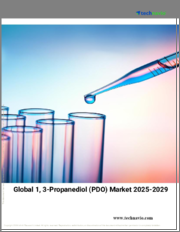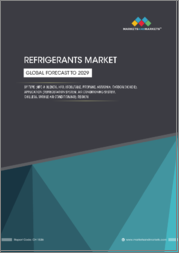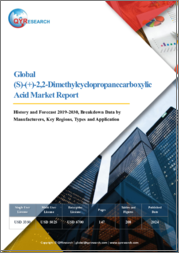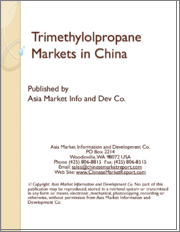
|
시장보고서
상품코드
1468560
프로판 시장 보고서 : 형태, 등급, 최종 사용 산업, 지역별(2024-2032년)Propane Market Report by Form (Liquid, Gas), Grade (HD-5 Propane, HD-10 Propane, Commercial Propane), End Use Industry (Residential, Commercial, Transportation, and Others), and Region 2024-2032 |
||||||
세계 프로판 시장 규모는 2023년 1억 8,110만 톤에 달했으며, IMARC Group은 2032년 시장 규모가 2억 4,870만 톤에 달하고, 2024-2032년 연평균 성장률(CAGR)이 3.5%를 나타낼 것으로 예측했습니다. 에너지 수요 증가, 산업 응용 분야 확대, 지정학적 사건과 유가의 영향을 받는 공급 역학, 청정 에너지원으로의 전환 등이 시장을 이끄는 주요 요인으로 꼽힙니다.
프로판은 알칸족에 속하는 무색, 무취의 기체로 3개의 탄소 원자와 8개의 수소 원자(C3H8)로 구성되어 있으며, 난방, 요리 및 다양한 산업 응용 분야의 연료 공급원으로 널리 사용되고 있습니다. 프로판은 주로 천연가스 처리나 원유 정제 과정에서 얻어집니다. 중간 압력에서 액화 석유 및 가스(LPG)가되어 가압 탱크에 저장됩니다. 깨끗한 연소 특성과 높은 에너지 함량으로 인해 주거 및 상업용 난방 시스템, 자동차, 휴대용 스토브 및 기타 신뢰할 수 있고 다재다능한 에너지원이 필요한 가전제품에 효율적인 선택이 되고 있습니다.
환경 문제에 대한 우려와 정부의 엄격한 규제로 인해 전 세계적으로 탈탄소화 및 지속 가능한 에너지원에 대한 관심이 높아짐에 따라, 상대적으로 저배출 및 효율적인 연료로 프로판의 채택이 증가하면서 시장 성장을 가속화하고 있습니다. 또한, 온실가스(GHG) 배출량이 적고 청정 연소 특성으로 인해 다양한 산업, 가정 및 운송 부문에서 기존 화석 연료보다 프로판을 선호하는 경향이 증가하고 있는 것도 시장 성장에 기여하고 있습니다. 또한, 석유화학 산업에서 플라스틱 및 화학제품 생산에 대한 원료 수요가 증가함에 따라 중요한 원료로서 프로판에 대한 수요가 증가하고 있어 시장 확대에 대한 밝은 전망을 제시하고 있습니다. 이 외에도 수송, 농업, 발전 등 다양한 분야에서 프로판의 범용성이 프로판 수요 증가에 기여하고 있습니다. 또한, 프로판 생산, 저장 및 유통 인프라의 상당한 기술 발전은 이 다목적 연료의 접근성과 경제성을 높여 시장 성장을 가속하고 있습니다.
프로판 시장 동향 및 촉진요인 :
에너지 수요와 전환
세계 프로판 산업의 주요 촉진요인 중 하나는 진화하는 에너지 상황입니다. 각국이 이산화탄소 배출량을 줄이고 청정 에너지원으로 전환하기 위해 노력하는 가운데, 프로판은 다재다능하고 환경 친화적인 대안으로 떠오르고 있습니다. 프로판은 석탄이나 석유와 같은 기존 화석연료에 비해 탄소 배출량이 적어 주택 난방, 요리, 운송 등 다양한 분야에서 매력적인 대안으로 떠오르고 있습니다. 천연가스 파이프라인에 대한 접근이 제한된 지역에서 프로판은 난방과 발전을 위해 쉽게 이용할 수 있는 대안으로 꼽힙니다. 이와는 별도로, 프로판은 비전기화 지역, 오지 및 백업 전력 시스템용 연료로서의 적응성이 신뢰할 수 있는 에너지 솔루션을 찾는 국가들 수요를 증가시키고 있습니다.
산업 응용 및 석유화학 수요
프로판의 중요성은 에너지에만 국한되지 않습니다. 번성하는 석유 화학 산업은 플라스틱, 화학 물질 및 기타 필수 재료를 생산하기위한 원료로 작용하기 때문에 프로판 수요를 촉진하는 데 중요한 역할을합니다. 전 세계적으로 플라스틱 소비가 계속 증가함에 따라 프로판 수요도 증가하고 있습니다. 다양한 석유화학 공정의 구성 요소로서 프로판의 다용도성은 제조 부문에서 프로판의 중요성을 강조하고 있습니다. 석유화학 산업의 성장과 기술 혁신은 프로판의 안정적이고 일관된 공급에 의존하고 있으며, 시장의 원동력으로서 프로판의 입지를 더욱 공고히 하고 있습니다.
시장 역학 및 공급 요인
지정학적 사건, 원유 가격의 변동, 공급의 혼란은 프로판 산업에 큰 영향을 미칩니다. 프로판은 대부분 천연가스 처리 및 원유 정제 과정에서 생산되는 제품입니다. 따라서 이러한 산업의 변화는 프로판의 가용성과 가격에 직접적인 영향을 미칩니다. 이와 마찬가지로, 지정학적 긴장과 주요 산유국의 결정으로 인한 생산 변동은 공급에 변동을 가져와 프로판 수요를 증가시킬 수 있습니다. 또한 기상 조건, 특히 난방에 필수적인 추운 지역에서는 프로판 수요가 증가합니다. 수요 및 공급의 균형은 가격 동향과 거래 패턴을 결정하는 매우 중요한 시장 역학이며, 시장 진출기업의 의사 결정과 투자 전략에 영향을 미칩니다.
목차
제1장 서문
제2장 조사 범위와 조사 방법
- 조사 목적
- 이해관계자
- 데이터 소스
- 1차 정보
- 2차 정보
- 시장 추정
- 보텀업 접근
- 톱다운 접근
- 조사 방법
제3장 주요 요약
제4장 서론
- 개요
- 주요 산업 동향
제5장 세계의 프로판 시장
- 시장 개요
- 시장 실적
- COVID-19의 영향
- 시장 예측
제6장 시장 분석 : 형태별
- 액체
- 기체
제7장 시장 분석 : 등급별
- HD-5 프로판
- HD-10 프로판
- 상업용 프로판
제8장 시장 분석 : 최종 이용 산업별
- 주택
- 상업
- 운송
- 기타
제9장 시장 분석 : 지역별
- 북미
- 미국
- 캐나다
- 아시아태평양
- 중국
- 일본
- 인도
- 한국
- 호주
- 인도네시아
- 기타
- 유럽
- 독일
- 프랑스
- 영국
- 이탈리아
- 스페인
- 러시아
- 기타
- 라틴아메리카
- 브라질
- 멕시코
- 기타
- 중동 및 아프리카
- 시장 동향
- 시장 분석 : 국가별
- 시장 예측
제10장 SWOT 분석
- 개요
- 강점
- 약점
- 기회
- 위협
제11장 밸류체인 분석
제12장 Porter의 Five Forces 분석
- 개요
- 바이어의 교섭력
- 공급 기업의 교섭력
- 경쟁 정도
- 신규 진출업체의 위협
- 대체품의 위협
제13장 가격 분석
제14장 경쟁 구도
- 시장 구조
- 주요 기업
- 주요 기업 개요
- Air Liquide S.A.
- BP plc
- Chevron Corporation
- China National Petroleum Corporation
- China Petroleum & Chemical Corporation
- ConocoPhillips Company
- Eni S.p.A.
- Evonik Industries AG
- Exxon Mobil Corporation
- GAIL(인도) Limited
- Gazprom
- Indian Oil Corporation Ltd.
- Royal Dutch Shell plc
- Saudi Arabian Oil Co.
- TotalEnergies SE
The global propane market size reached 181.1 Million Tons in 2023. Looking forward, IMARC Group expects the market to reach 248.7 Million Tons by 2032, exhibiting a growth rate (CAGR) of 3.5% during 2024-2032. The growing energy demand, expanding industrial applications, supply dynamics influenced by geopolitical events and crude oil prices, and the transition to cleaner energy sources are some of the major factors propelling the market.
Propane is a colorless, odorless gas belonging to the alkane family. It comprises three carbon atoms and eight hydrogen atoms (C3H8) and is widely used as a fuel source for heating, cooking, and various industrial applications. Propane is often derived from natural gas processing or crude oil refining. It becomes a liquefied petroleum gas (LPG) under moderate pressure and is stored in pressurized tanks. Its clean-burning properties and high energy content make it an efficient choice for residential and commercial heating systems, as well as vehicles, portable stoves, and other appliances that require a reliable and versatile source of energy.
The escalating global push towards decarbonization and sustainable energy sources due to environmental concerns and stringent government regulations have bolstered the adoption of propane as a relatively low-emission and efficient fuel source, thus primarily accelerating the market growth. In addition to this, the rising preference for propane over traditional fossil fuels, due to its lower greenhouse gas (GHG) emissions and clean-burning characteristics, across various industrial verticals, households, and transportation sectors are contributing to the market's growth. Furthermore, the petrochemical industry's expanding need for feedstock in the production of plastics and chemicals has heightened the demand for propane as a crucial raw material, creating a positive outlook for market expansion. Besides this, the versatility of propane across sectors, such as transportation, agriculture, and power generation, are contributing to the increasing demand for propane. Moreover, significant technological advancements in propane production, storage, and distribution infrastructure have enhanced the accessibility and affordability of this versatile fuel, thereby strengthening the market growth.
Propane Market Trends/Drivers:
Energy demand and transition
One of the prime drivers of the global propane industry is the evolving energy landscape. With various countries striving towards reducing their carbon footprint and transitioning towards cleaner energy sources, propane emerges as a versatile and environmentally friendly option. Propane's lower carbon emissions compared to traditional fossil fuels, such as coal and oil, position it as an attractive choice for various applications, particularly in residential heating, cooking, and transportation. In regions with restricted access to natural gas pipelines, propane offers an accessible alternative for heating and power generation. Apart from this, its adaptability as a fuel for off-grid areas, remote locations, and backup power systems enhances its demand as countries seek reliable energy solutions.
Industrial applications and petrochemical demand
Propane's significance extends beyond energy. The thriving petrochemical industry plays a crucial role in driving propane demand, as it serves as a feedstock to produce plastics, chemicals, and other essential materials. As global consumption of plastics continues to rise, so does the demand for propane. The versatile nature of propane as a building block for various petrochemical processes underscores its importance in the manufacturing sector. The petrochemical industry's growth and innovation rely on a stable and consistent supply of propane, further solidifying its position as a driving force in the market.
Market dynamics and supply factors
Geopolitical events, changes in crude oil prices, and supply disruptions exert significant influence on the propane industry. Propane is often a byproduct of natural gas processing and crude oil refining. Therefore, shifts in these industries directly impact propane availability and pricing. In line with this, production changes due to geopolitical tensions or decisions by major oil-producing countries can create fluctuations in supply, bolstering the demand for propane. Furthermore, weather conditions, especially in cold regions where it is essential for heating, are impelling the demand for propane. The balance between supply and demand is a pivotal market dynamic that can determine price trends and trade patterns, influencing market participants' decisions and investment strategies.
Propane Industry Segmentation:
IMARC Group provides an analysis of the key trends in each segment of the global propane market report, along with forecasts at the global, regional and country levels for 2024-2032. Our report has categorized the market based on form, grade and end use industry.
Breakup by Form:
Liquid
Gas
The report has provided a detailed breakup and analysis of the market based on the form. This includes liquid and gas.
Liquid propane, often referred to as LPG, is prized for its portability and ease of storage, making it a favored choice for residential, commercial, and industrial settings. Moreover, the expanding use of LPG as a crucial energy source for off-grid locations, remote areas, and outdoor activities, such as camping and grilling, is acting as another significant growth-inducing factor. Besides this, the convenience of transportable LPG cylinders and tanks allows for flexible usage in various appliances, thereby propelling the market forward. Apart from this, the surging need for constant gas propane supply, delivered through pipelines in urban areas and industries for powering heating systems, stoves, and industrial processes efficiently, is strengthening the market growth. Concurrently, the complementary nature of liquid and gas propane caters to diverse energy needs and ultimately impels their combined demand across a spectrum of applications.
Breakup by Grade:
HD-5 Propane
HD-10 Propane
Commercial Propane
The report has provided a detailed breakup and analysis of the market based on the grade. This includes HD-5, HD-10, and commercial propane.
The rising use of HD-5 propane in applications that require precise and consistent combustion, such as in forklifts, residential heating, and food processing, owing to its high purity and low moisture content, is contributing to the market's growth. In addition to this, HD-10 propane, with slightly relaxed purity standards, remains a popular choice for similar applications, offering a cost-effective alternative while maintaining acceptable performance. Furthermore, the surging demand for commercial propane across a wide array of industrial verticals, including agriculture, construction, hospitality, and transportation, due to its versatility and adaptability to various equipment and processes, is presenting lucrative opportunities for the market. Concurrent with this, the widespread product utilization as a reliable fuel source, supporting operations ranging from irrigation pumps and space heating to fleet vehicles, is aiding in market expansion.
Breakup by End Use Industry:
Residential
Commercial
Transportation
Others
Residential holds the largest share in the market
A detailed breakup and analysis of the market based on the end use industry has also been provided in the report. This includes residential, commercial, transportation, and others. According to the report, residential accounted for the largest market share.
The growing use of propane in the residential sector is driven by its distinctive advantages and contributions to modern living. As homeowners increasingly prioritize energy efficiency and environmental responsibility, propane emerges as a clean-burning alternative that significantly reduces GHG emissions compared to traditional fossil fuels. Moreover, its versatility in powering a range of residential applications, including space and water heating, cooking, and backup power generation, is contributing to the market's growth. In addition to this, propane's widespread availability, especially in areas without natural gas infrastructure, ensures consistent access to energy for households. Furthermore, ongoing technological advancements have enhanced propane appliances' efficiency and safety, further boosting their appeal.
Breakup by Region:
North America
United States
Canada
Asia-Pacific
China
Japan
India
South Korea
Australia
Indonesia
Others
Europe
Germany
France
United Kingdom
Italy
Spain
Russia
Others
Latin America
Brazil
Mexico
Others
Middle East and Africa
Asia Pacific exhibits a clear dominance, accounting for the largest propane market share
The market research report has also provided a comprehensive analysis of all the major regional markets, which include North America (the United States and Canada); Europe (Germany, France, the United Kingdom, Italy, Spain, Russia, and others); Asia Pacific (China, Japan, India, South Korea, Australia, Indonesia, and others); Latin America (Brazil, Mexico, and others); and the Middle East and Africa. According to the report, Asia Pacific accounted for the largest market share.
The Asia Pacific propane market is experiencing robust growth driven by rapid urbanization, industrialization, and economic development. Besides this, widespread product utilization across various sectors, such as manufacturing, agriculture, and residential heating, is contributing to the market's growth. In countries such as China and India, where energy consumption is soaring, propane serves as a cleaner alternative, aligning with governmental efforts to mitigate air pollution and reduce carbon emissions. Moreover, the expansion of LPG distribution networks and increased consumer awareness are further bolstering propane's role in catering to the rising energy needs of both urban and rural areas. The region's strategic investments in propane infrastructure, coupled with its burgeoning middle class and evolving energy policies, are aiding in market expansion.
Competitive Landscape:
The global propane industry is characterized by a dynamic competitive landscape shaped by various factors. Key players in the market include major oil and gas companies, regional energy providers, and LPG distributors. These players often engage in exploration, production, and distribution activities, influencing supply dynamics. Market competitiveness is also driven by the diverse applications of propane, ranging from residential heating and cooking to industrial processes and transportation. The growth of cleaner energy trends has prompted these companies to invest in research and development to enhance propane efficiency and environmental performance. Geopolitical events, supply disruptions, and fluctuations in crude oil prices significantly shape the competitive environment, impacting pricing and trade dynamics. Regulatory frameworks, environmental policies, and technological advancements further contribute to competitive strategies as companies strive to meet evolving market demands.
The report has provided a comprehensive analysis of the competitive landscape in the market. Detailed profiles of all major companies have also been provided. Some of the key players in the market include:
Air Liquide S.A.
BP plc
Chevron Corporation
China National Petroleum Corporation
China Petroleum & Chemical Corporation
ConocoPhillips Company
Eni S.p.A.
Evonik Industries AG
Exxon Mobil Corporation
GAIL (India) Limited
Gazprom
Indian Oil Corporation Ltd.
Royal Dutch Shell plc
Saudi Arabian Oil Co.
TotalEnergies SE
Recent Developments:
In August 2023, Chevron Corporation announced its acquisition of PDC Energy, Inc. The acquisition includes 275,000 net acres in the Denver-Julesburg Basin and 25,000 net acres in the Permian Basin, adding over 1 billion barrels of proved reserves.
Key Questions Answered in This Report
- 1. What was the size of the global propane market in 2023?
- 2. What is the expected growth rate of the global propane market during 2024-2032?
- 3. What are the key factors driving the global propane market?
- 4. What has been the impact of COVID-19 on the global propane market?
- 5. What is the breakup of the global propane market based on the end use industry?
- 6. What are the key regions in the global propane market?
- 7. Who are the key players/companies in the global propane market?
Table of Contents
1 Preface
2 Scope and Methodology
- 2.1 Objectives of the Study
- 2.2 Stakeholders
- 2.3 Data Sources
- 2.3.1 Primary Sources
- 2.3.2 Secondary Sources
- 2.4 Market Estimation
- 2.4.1 Bottom-Up Approach
- 2.4.2 Top-Down Approach
- 2.5 Forecasting Methodology
3 Executive Summary
4 Introduction
- 4.1 Overview
- 4.2 Key Industry Trends
5 Global Propane Market
- 5.1 Market Overview
- 5.2 Market Performance
- 5.3 Impact of COVID-19
- 5.4 Market Forecast
6 Market Breakup by Form
- 6.1 Liquid
- 6.1.1 Market Trends
- 6.1.2 Market Forecast
- 6.2 Gas
- 6.2.1 Market Trends
- 6.2.2 Market Forecast
7 Market Breakup by Grade
- 7.1 HD-5 Propane
- 7.1.1 Market Trends
- 7.1.2 Market Forecast
- 7.2 HD-10 Propane
- 7.2.1 Market Trends
- 7.2.2 Market Forecast
- 7.3 Commercial Propane
- 7.3.1 Market Trends
- 7.3.2 Market Forecast
8 Market Breakup by End Use Industry
- 8.1 Residential
- 8.1.1 Market Trends
- 8.1.2 Market Forecast
- 8.2 Commercial
- 8.2.1 Market Trends
- 8.2.2 Market Forecast
- 8.3 Transportation
- 8.3.1 Market Trends
- 8.3.2 Market Forecast
- 8.4 Others
- 8.4.1 Market Trends
- 8.4.2 Market Forecast
9 Market Breakup by Region
- 9.1 North America
- 9.1.1 United States
- 9.1.1.1 Market Trends
- 9.1.1.2 Market Forecast
- 9.1.2 Canada
- 9.1.2.1 Market Trends
- 9.1.2.2 Market Forecast
- 9.1.1 United States
- 9.2 Asia-Pacific
- 9.2.1 China
- 9.2.1.1 Market Trends
- 9.2.1.2 Market Forecast
- 9.2.2 Japan
- 9.2.2.1 Market Trends
- 9.2.2.2 Market Forecast
- 9.2.3 India
- 9.2.3.1 Market Trends
- 9.2.3.2 Market Forecast
- 9.2.4 South Korea
- 9.2.4.1 Market Trends
- 9.2.4.2 Market Forecast
- 9.2.5 Australia
- 9.2.5.1 Market Trends
- 9.2.5.2 Market Forecast
- 9.2.6 Indonesia
- 9.2.6.1 Market Trends
- 9.2.6.2 Market Forecast
- 9.2.7 Others
- 9.2.7.1 Market Trends
- 9.2.7.2 Market Forecast
- 9.2.1 China
- 9.3 Europe
- 9.3.1 Germany
- 9.3.1.1 Market Trends
- 9.3.1.2 Market Forecast
- 9.3.2 France
- 9.3.2.1 Market Trends
- 9.3.2.2 Market Forecast
- 9.3.3 United Kingdom
- 9.3.3.1 Market Trends
- 9.3.3.2 Market Forecast
- 9.3.4 Italy
- 9.3.4.1 Market Trends
- 9.3.4.2 Market Forecast
- 9.3.5 Spain
- 9.3.5.1 Market Trends
- 9.3.5.2 Market Forecast
- 9.3.6 Russia
- 9.3.6.1 Market Trends
- 9.3.6.2 Market Forecast
- 9.3.7 Others
- 9.3.7.1 Market Trends
- 9.3.7.2 Market Forecast
- 9.3.1 Germany
- 9.4 Latin America
- 9.4.1 Brazil
- 9.4.1.1 Market Trends
- 9.4.1.2 Market Forecast
- 9.4.2 Mexico
- 9.4.2.1 Market Trends
- 9.4.2.2 Market Forecast
- 9.4.3 Others
- 9.4.3.1 Market Trends
- 9.4.3.2 Market Forecast
- 9.4.1 Brazil
- 9.5 Middle East and Africa
- 9.5.1 Market Trends
- 9.5.2 Market Breakup by Country
- 9.5.3 Market Forecast
10 SWOT Analysis
- 10.1 Overview
- 10.2 Strengths
- 10.3 Weaknesses
- 10.4 Opportunities
- 10.5 Threats
11 Value Chain Analysis
12 Porters Five Forces Analysis
- 12.1 Overview
- 12.2 Bargaining Power of Buyers
- 12.3 Bargaining Power of Suppliers
- 12.4 Degree of Competition
- 12.5 Threat of New Entrants
- 12.6 Threat of Substitutes
13 Price Analysis
14 Competitive Landscape
- 14.1 Market Structure
- 14.2 Key Players
- 14.3 Profiles of Key Players
- 14.3.1 Air Liquide S.A.
- 14.3.1.1 Company Overview
- 14.3.1.2 Product Portfolio
- 14.3.1.3 Financials
- 14.3.1.4 SWOT Analysis
- 14.3.2 BP plc
- 14.3.2.1 Company Overview
- 14.3.2.2 Product Portfolio
- 14.3.2.3 Financials
- 14.3.2.4 SWOT Analysis
- 14.3.3 Chevron Corporation
- 14.3.3.1 Company Overview
- 14.3.3.2 Product Portfolio
- 14.3.3.3 Financials
- 14.3.3.4 SWOT Analysis
- 14.3.4 China National Petroleum Corporation
- 14.3.4.1 Company Overview
- 14.3.4.2 Product Portfolio
- 14.3.4.3 SWOT Analysis
- 14.3.5 China Petroleum & Chemical Corporation
- 14.3.5.1 Company Overview
- 14.3.5.2 Product Portfolio
- 14.3.5.3 Financials
- 14.3.5.4 SWOT Analysis
- 14.3.6 ConocoPhillips Company
- 14.3.6.1 Company Overview
- 14.3.6.2 Product Portfolio
- 14.3.6.3 Financials
- 14.3.6.4 SWOT Analysis
- 14.3.7 Eni S.p.A.
- 14.3.7.1 Company Overview
- 14.3.7.2 Product Portfolio
- 14.3.7.3 Financials
- 14.3.7.4 SWOT Analysis
- 14.3.8 Evonik Industries AG
- 14.3.8.1 Company Overview
- 14.3.8.2 Product Portfolio
- 14.3.8.3 Financials
- 14.3.8.4 SWOT Analysis
- 14.3.9 Exxon Mobil Corporation
- 14.3.9.1 Company Overview
- 14.3.9.2 Product Portfolio
- 14.3.9.3 Financials
- 14.3.9.4 SWOT Analysis
- 14.3.10 GAIL (India) Limited
- 14.3.10.1 Company Overview
- 14.3.10.2 Product Portfolio
- 14.3.10.3 Financials
- 14.3.10.4 SWOT Analysis
- 14.3.11 Gazprom
- 14.3.11.1 Company Overview
- 14.3.11.2 Product Portfolio
- 14.3.11.3 Financials
- 14.3.11.4 SWOT Analysis
- 14.3.12 Indian Oil Corporation Ltd.
- 14.3.12.1 Company Overview
- 14.3.12.2 Product Portfolio
- 14.3.12.3 Financials
- 14.3.12.4 SWOT Analysis
- 14.3.13 Royal Dutch Shell plc
- 14.3.13.1 Company Overview
- 14.3.13.2 Product Portfolio
- 14.3.13.3 Financials
- 14.3.14 Saudi Arabian Oil Co.
- 14.3.14.1 Company Overview
- 14.3.14.2 Product Portfolio
- 14.3.14.3 Financials
- 14.3.14.4 SWOT Analysis
- 14.3.15 TotalEnergies SE
- 14.3.15.1 Company Overview
- 14.3.15.2 Product Portfolio
- 14.3.15.3 Financials
- 14.3.15.4 SWOT Analysis
- 14.3.1 Air Liquide S.A.




















